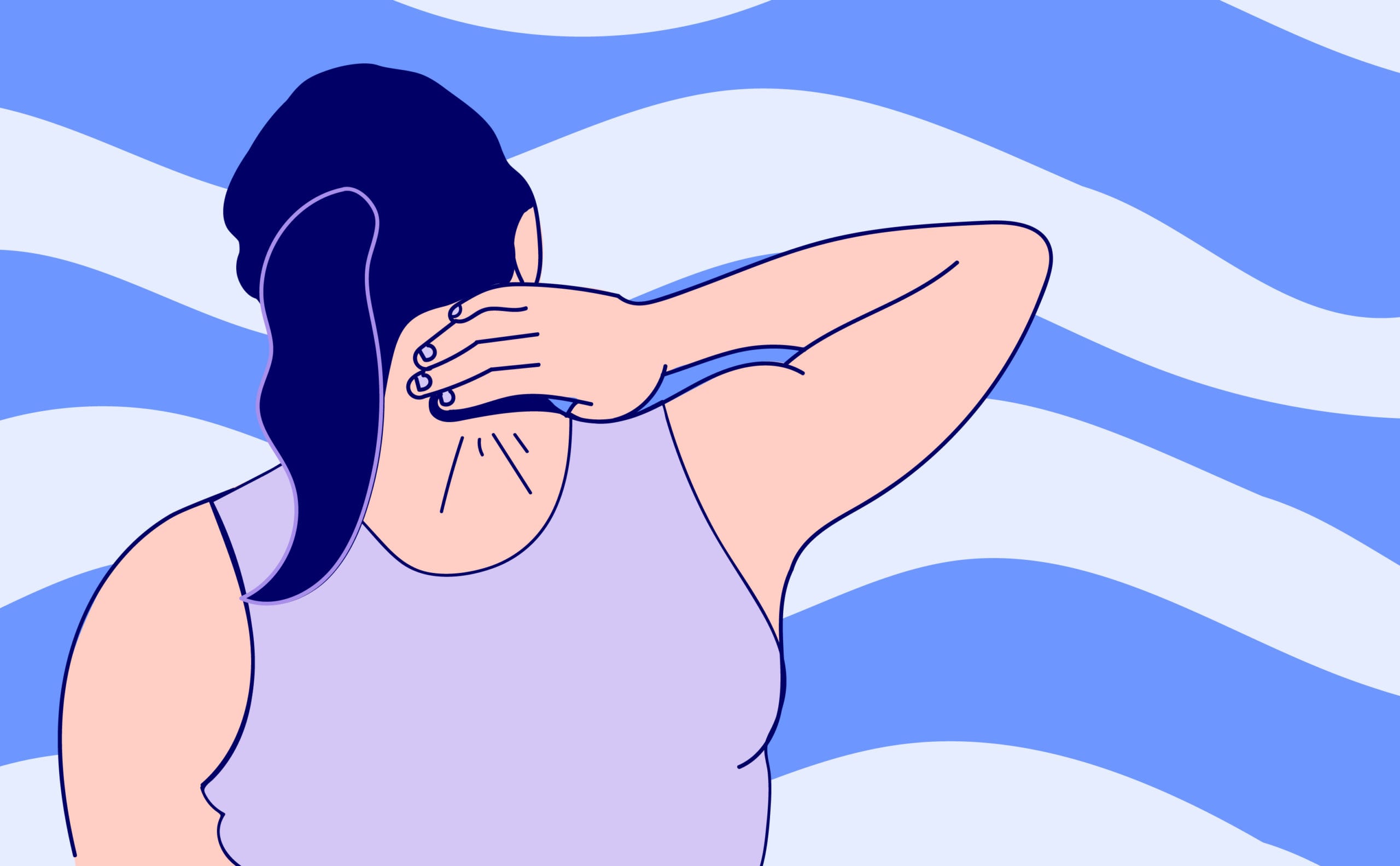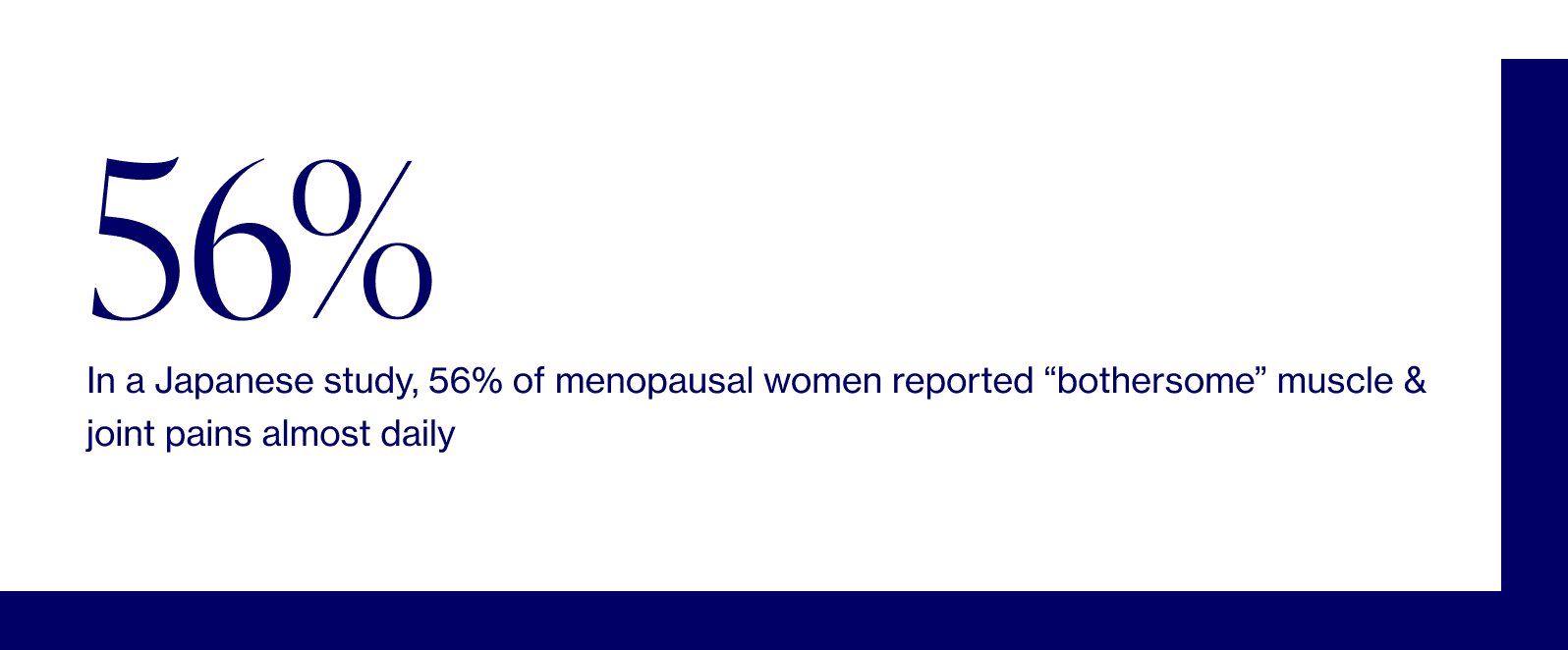In medical lingo, joint aches are known as “arthralgia” and muscle aches, “myalgia.” Both become increasingly common with age and the onset of menopause — a double whammy.
These aches can be localized to specific joints or generalized to an area (think neck or back pain), and tend to be worse in the morning, or after a prolonged time spent sitting, and usually improve throughout the day.

While scientists have yet to identify one single cause, they have presented a whole slew of evidence-based hypotheses.
Natural aging
Muscle mass peaks in our 20s. And while it may begin declining in our 30s, it’s really in our 40s and 50s that the loss of muscle mass, strength, and function accelerates the most. Known as “sarcopenia,” the condition may cause feelings of soreness. (Note: this is different from the achiness you may feel from working out.)
But unlike most symptoms that pay us a visit during these years, sarcopenia doesn’t seem to be majorly affected by decreases in estrogen. In fact, cross-sectional studies evaluating the effects of age on lean body mass and appendicular muscle mass have shown that the rate of muscle mass decline for females doesn’t necessarily increase after menopause. In other words, it is both aging in general as well as the hormonal change of menopause that contributes to the loss of lean muscle mass.
Inflammation
Sarcopenia may not be influenced by hormonal changes and fluctuations, but inflammation definitely is.
Quick pause for those of us who want a refresher on inflammation even…as our body’s normal response to infection or injury, inflammation is what causes damaged tissues to release chemicals that signal to white blood cells that it’s time to start repairing — which is totally a good thing and exactly what we want to happen when there’s an injury. What we DON’T want, however, is for inflammation to become chronic and spread throughout the body, because then it can cause joint stiffness and pain, among other troubles.
Estrogen wears many hats, one of which is reducing inflammation by binding to the specific estrogen receptors in our joints and connective tissues like cartilage and ligaments. So when levels of this hormone decrease during menopause, it can affect cartilage metabolism and lead to inflammatory-like pain. Estrogen also plays a role in joint lubrication, so declining estrogen = declining lubrication = more wear and tear on joints = increased risk of pain.
In addition to declining estrogen, the menopausal transition is also marked by declining progesterone. This estrogen-balancing hormone also has potent anti-inflammatory properties and there is emerging science about its role in joint and muscle disorders, from the aches and pains of menopause to fibromyalgia to arthritis. For example, higher progesterone levels seem to have a protective effect in premenopausal women with fibromyalgia. There are also studies showing a positive effect of combined (estrogen and progesterone) hormone therapy on women with this condition, although more research needs to be done to identify the optimal timing, regimen, and dose — and it may differ individually! Although currently progesterone alone is not recommended as a treatment for joint and muscle pain, studies are ongoing and we will likely have a better understanding of its role in the next few years.
Also worth noting is the fact that estrogen levels may play a role in what’s called “pain modulation,” or the way we experience a painful sensation. This may explain why fibromyalgia — a condition characterized by widespread musculoskeletal pain — is ten times more common in women than men, with symptoms appearing in as many as 58% of postmenopausal women. According to Mayo Clinic, “widespread” in this definition means the “pain must occur on both sides of your body and above and below your waist.”
Risk factors
Researchers have identified several risk factors for bodily aches and pains, including depression, high BMI or body weight, insomnia, and rheumatoid arthritis.
Insomnia
This one works both ways, meaning insomnia (defined as difficulty falling or staying asleep more than three nights/week) can be both a result and cause of myalgia/arthralgia.
Rheumatoid Arthritis
Rheumatoid arthritis is a chronic autoimmune inflammatory disorder that causes the body’s immune system to attack its own tissues and joints, causing swelling and feelings of achiness. Women are 2-4 times more likely to experience rheumatoid arthritis than men. It usually appears in the late 40s, suggesting (but not proving) that fluctuating hormone levels during perimenopause may play a role in the condition.
Osteoarthritis
Like rheumatoid arthritis, osteoarthritis affects our joints; however, unlike its rheumatoid cousin, it is not an autoimmune problem. Instead, it’s classified as a “degenerative joint condition” (what a sad name, we know). This is an important point of differentiation since autoimmune disorders cause the body to essentially attack itself, while degenerative disorders cause the cartilage cushioning the joints to break down over time. When this happens, bones rub against each other, exposing nerves and causing pain.
Some refer to osteoarthritis as the “arthritis of menopause” since it primarily affects us around age 52.
Could your joint and muscle pain be caused by something NOT be menopause-related? Of course. So if you find that it’s 1) increasing over time without relief or 2) interfering with your daily activities and quality of life, it’s worth consulting your healthcare provider.
Dr. Anna Barbieri, MD
Pro tip #1
Joints can stiffen up during periods of inactivity, which is why it’s so important to keep moving — even if that means marching in place for 30 seconds every 30 minutes or investing in a standing desk if you spend most of your day seated at the computer. Try this easy, low-tech trick to make sure you get moving!





